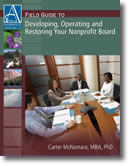(Sample!) “Supervisory Skills Development Plan”
for an Executive Director Who’s Struggling with Supervisory Skills
© Copyright Carter McNamara, MBA, PhD, Authenticity Consulting, LLC. Also see Carter’s Board Blog (for for-profits and nonprofits).
The document is a sample of a rather detailed, emergency-driven development plan from a board to an executive director, “Jim Struggles,” who struggles to develop basic supervisory skills in his leadership role of Agency-in-Need. Typically, a board is not this hands-on, unless the chief executive clearly needs the help. This struggle is not all that uncommon, particularly with leaders who are highly entrepreneurial. This type of development plan might be posed by a Personnel Committee, staffed by one or two experienced managers who recognize the need for the change in management style by the executive director. The plan would be reviewed by the Committee with the Board Chair and then, if acceptable, posed to the chief executive to work an accommodating arrangement. Next, the entire board might review and authorize the plan if there is not strong contention (in which case, there may be other issues to work). This plan could be adopted by the chief executive and the board as mutual means to develop the chief executive and ensure the long-term health of the organization. Note that detailed nature of this plan is to provide Jim an example of the clear, specific nature needed by him in his performance reviews of his staff — an area in which he struggles.
Description
Considering the specific staff-related issues now in Organization-in-Need and the supervisory area where the Executive Director, Jim Struggles, agrees he needs to improve, the Board Development and Personnel Committee suggests that Jim implement this supervisory skills development plan. This “back to the basics” plan is straightforward, specific and starts small for now. After the following activities have been conducted reliably, then the plan could be embellished. Consistent performance of the following activities by Jim will develop more stability in Organization-in-Need , ultimately requiring less supervisoral time from Jim, making Jim more proactive, increasing staff morale and improving performance. Note that this plan is focused specifically to supporting Jim’s supervisory skills and does not replace the formal performance evaluation conducted once a year by the Organization-in-Need board.
1. Realign his priorities (this development plan guides this realignment)
– he considers himself weak in needed supervisory skills, and ends up focusing on doing what he’s good at and what has built Organization-in-Need so far: fundraising (nonprofit only), speaking and organizing
– for now he needs to refocus more on internal development and less on expansion
– he should stay around the office more to conduct the following supervisoral activities
2. Manage staff performance — performance based on behaviors in the workplace
(Note that the following suggestions should be in accordance with the organization’s official (authorized by the board) personnel policies.)
– avoiding performance issues ultimately decreases morale, decreases Jim’s credibility, decreases Organization-in-Need’s overall effectiveness and wastes more of Jim’s time when he resorts to doing other staff’s jobs because they don’t seem capable of doing them
– he should consistently get written weekly status reports from direct reports; these are useful for understanding and monitoring work, and as a basis for training new staff if needed
– when an important job is not done or is done poorly, immediately tell the employee and store away a brief note of reminder about the event; ask the staff member if they need any special resources they don’t currently have to complete the job, and if so, see that they soon get the resources; if the resources are personal in nature, e.g., they need therapy, then be empathetic, but realize this is their responsibility and continue to focus on their conducting the behaviors needed to effectively do their job at Organization-in-Need
– on a second occurrence of a job being done poorly by the employee, write a memo to the employee and present it to him or her in a meeting; in the memo, indicate what you saw that needs improvement, that you talked to the employee before and on what date, again ask if there’s anything you can do to help the employee improve. Tell the board of the situation.
– on the third occurrence of a job being done poorly, promptly document the issue in a “warning” memo again provided to the employee in a 1-on-1 meeting; in the memo, describe the issue including previous conversations about the issue, and warn that if the issue occurs again, they will be fired
– on the fourth occurrence, fire the employee (Organization-in-Need deserves good employees!!!)
3. Consistently hold staff meetings (builds teams, reduces stress and Jim’s so he is more proactive)
– this ultimately produces more efficient time management and supervision for Jim
– for clarity, focus and morale, be sure to use agendas and ensure follow-up minutes
– in meetings, review the overall condition of Agency-in-Need and review recent successes of Agency-in-Need
– in meetings, have each member give an overview of current activities and planned activities
– in meetings, plan the activities that require mutual coordination among managers
4. Have consistent 1-on-1 monthly meetings with direct reports
– this ultimately produces more efficient time management and supervision
– guide “sudden” supervisoral issues to be handled later, in these 1-on-1 meetings
– review completed activities and planned activities (more specifically than in staff meetings); it’s typical to be surprised at what and how much is going on of which the leader isn’t aware
– leave time near the end of the meetings for Q and A from the staff member
– start basic performance reviews with each staff; these meetings will greatly facilitate performance review planning and implementation; these reviews build accountability and morale; staff deserve reviews; include the staff member’s input to the reviews
5. Manage and report on the budget
– Jim has many of the skills needed to manage the budget; he needs refocus to the budget
– he should analyze the budget himself, including for a) highlights, b) trends and c) issues
– he should present this information himself in a report to the board
6. Establish and enforce personnel policies and procedures to effectively deal with recurrent issues
– make a list of recurrent issues, e.g., staff doesn’t promptly hand in client payments
– write a policy with a procedure for each issue, e.g., of how payments should be handled
– have the board personnel committee review the policy
– work the policy — make every effort not to perform the procedure himself
7. Cap his work hours at a maximum of 50 hours a week
– these suggested activities will likely be somewhat uncomfortable (at first) for Jim — board members hope that he’ll likely come to appreciate the simplicity and benefits of these regular actions
– this cap is a rather straightforward measure to help ensure a reasonable stress and work load
8. Once a year, schedule a half-day session with all staff to update policies and procedures
– for smaller organizations that are usually averse to policies, this once-a-year event seems to effectively focus staff attention on policies and procedures, ensure all staff members are aware of them and ensure policies exist where needed
Milestones for Implementation of this Plan
This plan produces certain tangible outputs which can reviewed to help guide Jim’s implementation of this development plan. Board members are available to help guide Jim in this effort, but would like to see items done by certain dates to ensure they’re not lost in a crack. Members would like to see Jim drive the effort to produce the following items by the following due dates.
|
Items to Review
|
“Due” Date
|
| 1. |
performance-issue letters
— Members are aware of two issues which deserve warning letters now; members would like to see the drafted letters |
Nov 17, `98
|
| 2. |
staff meeting agendas and minutes |
monthly for several
months
|
| 3. |
status reports from direct reports |
examples in Dec and Jan
|
| 4. |
performance reviews
— a) Jim’s drafted procedure of how he’d like to carry out these reviews, b) drafted reviews for all direct reports, and c) final reviews after having met with direct reports |
a) in Jan, `99
b) some drafts in Feb `99
c) some finals as they occur
|
| 5. |
budget reports
— these can be presented to board members in regular board meetings; perhaps the Finance Committee could help Jim to understand the notion of “highlights, trends and issues”? |
in monthly board meetings |
| 6. |
current issues and associated drafted policies and procedures
—
Jim mentioned several issues to me in our meeting today |
Dec. 15, `98
|
Return to Board of Director’s Evaluation of Chief Executive
For the Category of Boards of Directors:
To round out your knowledge of this Library topic, you may want to review some related topics, available from the link below. Each of the related topics includes free, online resources.
Also, scan the Recommended Books listed below. They have been selected for their relevance and highly practical nature.











